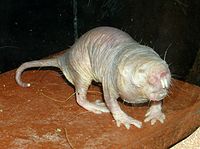
Photo from wikipedia
Dominant females of cooperative breeding species often use aggression to suppress reproduction of subordinate females, resulting in subordinates experiencing stress-related increases in glucocorticoid levels, which may cause reproductive down-regulation. This… Click to show full abstract
Dominant females of cooperative breeding species often use aggression to suppress reproduction of subordinate females, resulting in subordinates experiencing stress-related increases in glucocorticoid levels, which may cause reproductive down-regulation. This would suggest a general pattern with higher glucocorticoid levels in subordinate compared to dominant individuals; however, the opposite was found in a number of cooperatively breeding species. Furthermore, breeding females of the cooperatively breeding Damaraland mole-rats (Fukomys damarensis) exhibit very high androgen concentrations during the wet season, presumably to support their breeding monopoly. Hormone analysis in Damaraland mole-rats have typically been measured using plasma and urine, but faecal analysis offers additional advantages especially for field studies on this species. The present study examines the suitability of Damaraland mole-rat faecal samples for determining glucocorticoid metabolite (fGCM) and androgen metabolite (fAM) concentrations using enzyme immunoassays. Using these assays, we further evaluated the effects of breeding status on fGCM and fAM concentrations in wild-caught and captive Damaraland mole-rats. Wild-caught breeding and non-breeding males and females exhibited no differences in fAM concentrations. Immunoreactive fGCM concentrations were only high in male breeders and comparatively low in non-breeders and breeding females. Concentrations of fAMs and fGCMs were similar in captive males and females, but fAM concentrations were elevated in captive compared to wild-caught individuals, which may be related to a higher reproductive activity due to removal from the breeding female. The relatively uniform fAM and fGCM concentrations found in wild-caught mole-rats may be explained by a stable colony structure during the dry season during which this study was conducted. Limited dispersal opportunities result in lower aggression and stress levels within a colony and as a result lower fAM and fGCM concentrations.
Journal Title: General and comparative endocrinology
Year Published: 2018
Link to full text (if available)
Share on Social Media: Sign Up to like & get
recommendations!